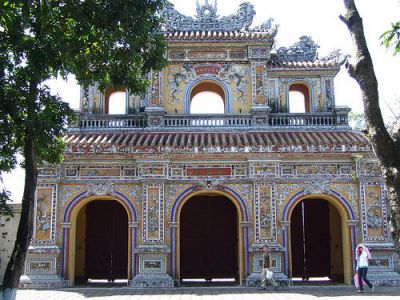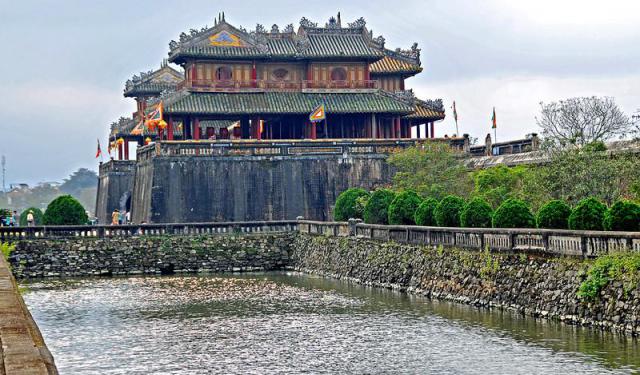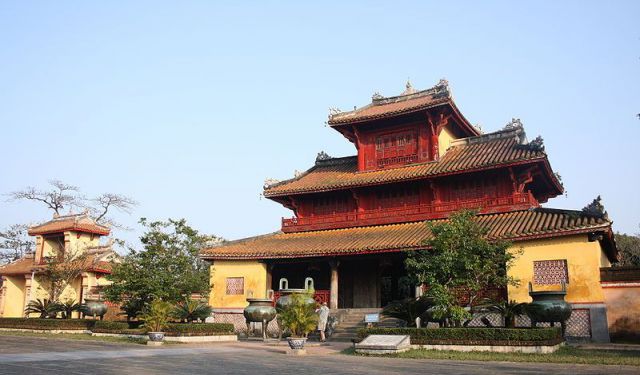Cửa Chương Đức (Chuong Duc Gate), Hue
Chuong Duc Gate, located on the western side of Hue’s Imperial Citadel, is one of the four principal entrances that once safeguarded the Nguyen Dynasty’s royal enclosure. Constructed in 1804 during the reign of Emperor Gia Long, the gate served multiple roles: it facilitated movement for women within the royal court, protected the palace's western flank, and reinforced the social and spatial divide between imperial life and the outer world. Its name, invoking the “four virtues” of a traditional woman in Confucian teachings, reflects the dynasty’s architectural adherence to symbolic order, particularly the principle of “left male, right female.”
Initially built in a simple three-entrance form without elaborate ornamentation, the gate underwent several renovations. A major restoration in 1921 under Emperor Khai Dinh transformed the structure with decorative enhancements and new materials. This period marked a turning point in the refinement of porcelain mosaic art in Vietnam. Chuong Duc Gate became an exemplar of the Nguyen dynasty’s use of intricate crockery and glass inlay, with vivid themes embedded into its multi-panel columns and elaborate rooflines.
The gate features a distinctive three-tiered design, with a tiled roof covered in yellow imperial glaze. Above the arched doorway, visitors can spot a round tile with the character “Tho” (longevity), while lower tiles are decorated with bat motifs-both common symbols of good fortune in imperial aesthetics. These rich visual details, combined with the gate’s functional history, offer insight into the cultural priorities of Vietnam’s last ruling dynasty.
Today, Chuong Duc Gate stands as a quieter counterpart to Hue’s more famous southern entrances. Its architectural subtleties and historical depth make it a rewarding stop for visitors seeking to explore the layered legacy of Vietnam’s imperial past beyond the main tourist trail.
Initially built in a simple three-entrance form without elaborate ornamentation, the gate underwent several renovations. A major restoration in 1921 under Emperor Khai Dinh transformed the structure with decorative enhancements and new materials. This period marked a turning point in the refinement of porcelain mosaic art in Vietnam. Chuong Duc Gate became an exemplar of the Nguyen dynasty’s use of intricate crockery and glass inlay, with vivid themes embedded into its multi-panel columns and elaborate rooflines.
The gate features a distinctive three-tiered design, with a tiled roof covered in yellow imperial glaze. Above the arched doorway, visitors can spot a round tile with the character “Tho” (longevity), while lower tiles are decorated with bat motifs-both common symbols of good fortune in imperial aesthetics. These rich visual details, combined with the gate’s functional history, offer insight into the cultural priorities of Vietnam’s last ruling dynasty.
Today, Chuong Duc Gate stands as a quieter counterpart to Hue’s more famous southern entrances. Its architectural subtleties and historical depth make it a rewarding stop for visitors seeking to explore the layered legacy of Vietnam’s imperial past beyond the main tourist trail.
Want to visit this sight? Check out these Self-Guided Walking Tours in Hue. Alternatively, you can download the mobile app "GPSmyCity: Walks in 1K+ Cities" from Apple App Store or Google Play Store. The app turns your mobile device to a personal tour guide and it works offline, so no data plan is needed when traveling abroad.
Cửa Chương Đức (Chuong Duc Gate) on Map
Sight Name: Cửa Chương Đức (Chuong Duc Gate)
Sight Location: Hue, Vietnam (See walking tours in Hue)
Sight Type: Attraction/Landmark
Guide(s) Containing This Sight:
Sight Location: Hue, Vietnam (See walking tours in Hue)
Sight Type: Attraction/Landmark
Guide(s) Containing This Sight:
Walking Tours in Hue, Vietnam
Create Your Own Walk in Hue
Creating your own self-guided walk in Hue is easy and fun. Choose the city attractions that you want to see and a walk route map will be created just for you. You can even set your hotel as the start point of the walk.
Hue Introduction Walking Tour
Once the seat of the imperial dynasty in the heart of Vietnam, Hue is chock-full of stories. During feudal times, for nearly 150 years – from 1802 to 1945, the city served as the national capital. The royal lifestyle and customs have had a strong impact on the lifestyle of locals, and this impact can still be felt today.
First cited about 200 BCE as the seat of the Chinese military authority... view more
Tour Duration: 2 Hour(s)
Travel Distance: 3.5 Km or 2.2 Miles
First cited about 200 BCE as the seat of the Chinese military authority... view more
Tour Duration: 2 Hour(s)
Travel Distance: 3.5 Km or 2.2 Miles
Imperial City Walking Tour
The Kings of the Nguyen Dynasty built their feudal capital along the fertile banks of the Perfume River, whose steady flow, centuries on, still sets up a languid pace that the rest of the city is happy to follow.
Situated within the walls of the Royal Citadel, The Imperial City in Hue is one of, if not the most prominent landmark in Vietnam, renowned for its wonderful collection of oriental... view more
Tour Duration: 2 Hour(s)
Travel Distance: 2.9 Km or 1.8 Miles
Situated within the walls of the Royal Citadel, The Imperial City in Hue is one of, if not the most prominent landmark in Vietnam, renowned for its wonderful collection of oriental... view more
Tour Duration: 2 Hour(s)
Travel Distance: 2.9 Km or 1.8 Miles





